Vestibular workouts strengthen your inner ear balance system, reducing dizziness and improving coordination. Try the Basic Bounce and Hold to build foundation, Directional Jumps for spatial awareness, and Vision-Focused Rebounding for gaze stability. Add Single-Leg Balance, Rhythmic Bouncing with head movements, and Proprioceptive Challenge Circuits to your routine. Practice at least three times daily for 6-12 weeks for noticeable improvements. These seven exercises will transform your balance capabilities with consistent practice.
7 Vestibular Workouts for Balance Mastery
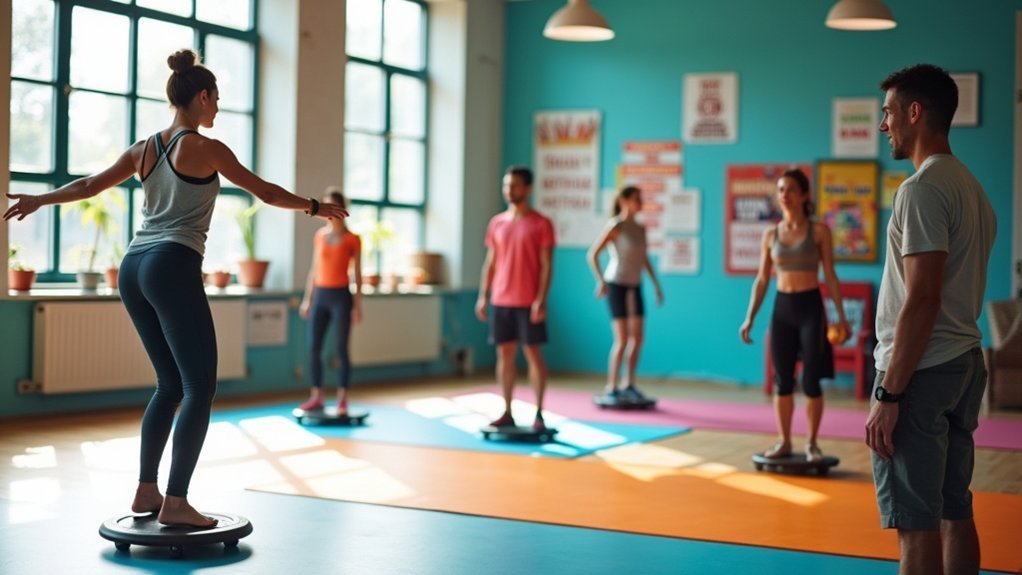
While many fitness programs focus on strength or cardio, vestibular workouts target the intricate balance system housed in your inner ear.
These specialized exercises that can help your brain compensate for balance-related issues can greatly reduce dizziness and improve coordination when practiced consistently.
Consistent vestibular training helps your brain adapt to balance challenges, dramatically reducing dizziness while enhancing overall coordination.
Vestibular rehabilitation exercises like gaze stabilization—where you keep your eyes fixed on a target while moving your head—enhance visual tracking capabilities over time.
Combining head movements with coordinated eye exercises trains your muscles and neural pathways to work together more efficiently.
Physical therapy approaches often include standing on one leg or tandem walking to build static and dynamic balance.
For lasting results, you’ll need to practice these exercises at least three times daily for 6-12 weeks, gradually challenging yourself as your balance improves.
Basic Bounce and Hold: Building Your Vestibular Foundation
Among the many vestibular exercises available, the Basic Bounce and Hold serves as an excellent starting point for anyone looking to improve their balance. This simple yet effective exercise involves gently bouncing on the balls of your feet while maintaining a straight torso and engaged core muscles.
Start with short sessions in a safe environment, gradually working up to 2-3 sets of 1-2 minutes each. You’ll quickly notice improvements in both proprioception and vestibular function as your body adapts to the controlled movement.
Ready for a challenge? Incorporate head movements or visual distractions to further stimulate your vestibular system. This progression forces your balance mechanisms to work harder, building greater stability over time.
With regular practice, you’ll develop a strong vestibular foundation that enhances your overall balance mastery.
Directional Jumps: Challenging Your Spatial Awareness
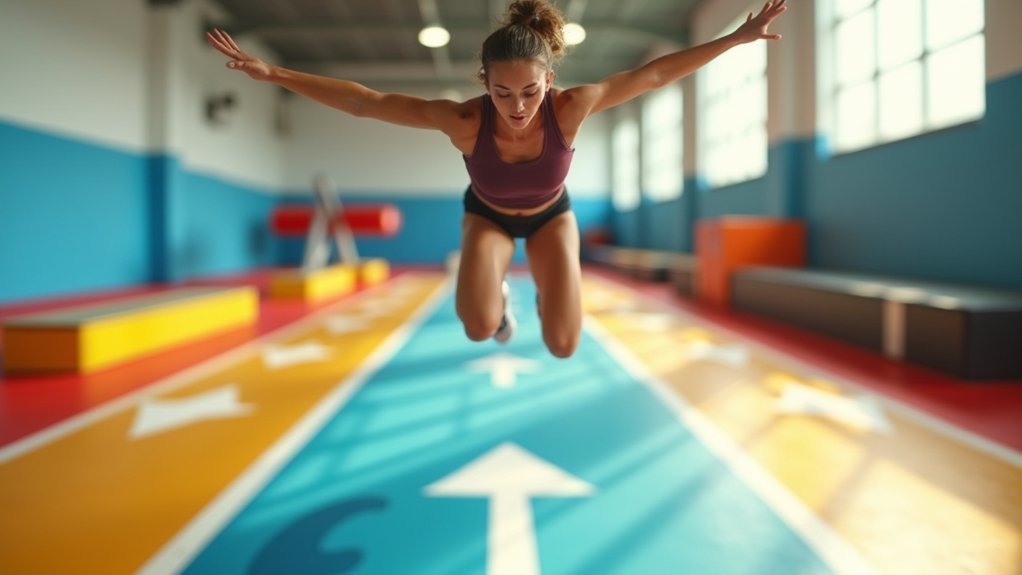
Directional jumps represent an essential progression in vestibular training that takes your balance abilities to new heights.
By leaping forward, backward, and sideways, you’re directly challenging your vestibular system to process multiple movement planes, enhancing your spatial awareness and coordination simultaneously.
Incorporating these movements into your workout routine simulates real-life scenarios where quick directional changes are necessary for balance mastery.
To maximize your directional jump training:
- Start with low-height, controlled jumps before increasing intensity
- Use visual markers or targets to focus your movements and improve exercise efficacy
- Progress gradually as your agility and confidence improve
This targeted approach trains your brain to rapidly adjust to changing orientations, ultimately improving your reaction time and stability in everyday movements.
Vision-Focused Rebounding: Gaze Stabilization Techniques
You’ll enhance your vestibular system through eye-brain recalibration exercises that train your vision to stay stable during movement.
Practice fixed-gaze movement patterns by focusing on a stationary target while slowly turning your head side-to-side or up-and-down for 30-second intervals.
These techniques help your brain adapt to vestibular signals, improving coordination and reducing dizziness when performed consistently against increasingly complex backgrounds.
Eye-Brain Recalibration Exercises
When your inner ear sustains damage, the connection between your eyes and brain requires deliberate recalibration to restore proper balance. Gaze stabilization exercises directly target this connection by training your ability to focus on stationary objects while moving your head.
To improve your vestibular system’s function and reduce symptoms of dizziness:
- Fix your gaze on a target at eye level in front of you (3-10 feet away) while moving your head side to side for 30 seconds
- Practice three times daily, gradually progressing from sitting to standing
- Introduce complex backgrounds to challenge your visual system further
These movements that provoke mild dizziness actually strengthen your brain’s compensation mechanisms.
Consistent practice helps reprogram how your brain processes visual information, ultimately helping improve one’s balance and vestibular efficiency.
Fixed-Gaze Movement Patterns
Building upon basic vestibular rehabilitation techniques, fixed-gaze movement patterns create a more challenging environment for your balance system to adapt and strengthen.
These gaze stabilization exercises require you to focus on a target while performing controlled head movements from side to side or up and down.
For best results, maintain your fixed gaze for 30 seconds during each exercise session, repeating multiple times throughout your day. You’ll gradually improve your visual stability by intentionally triggering controlled episodes of dizziness, which helps your brain readjust to head motion.
As you progress in vestibular rehabilitation, increase difficulty by practicing against more complex visual backgrounds.
This deliberate challenge helps retrain your brain’s ability to process visual information while moving, ultimately enhancing your balance and coordination in everyday activities.
Single-Leg Balance Progressions on the Mini Trampoline
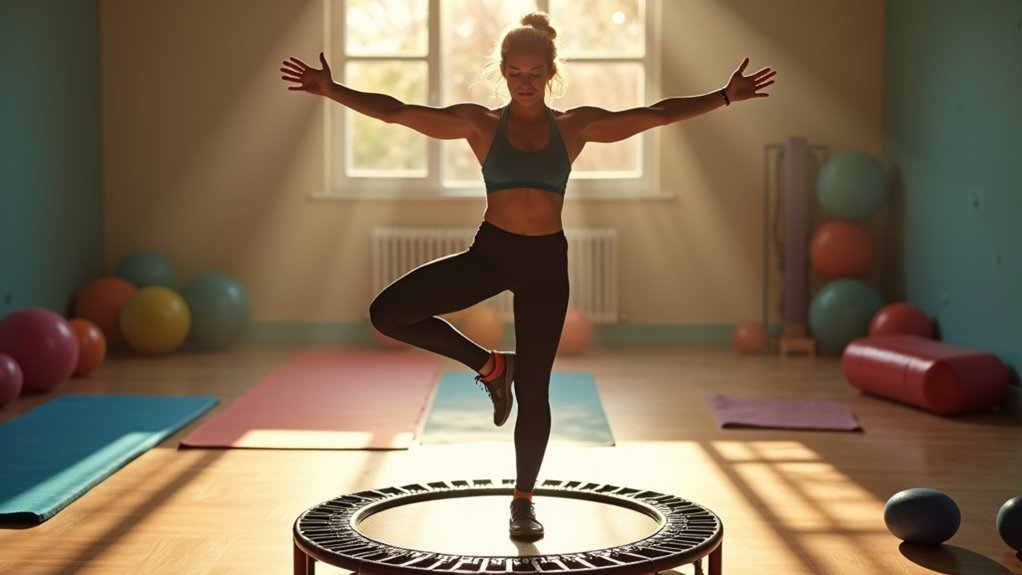
Challenging both stability and coordination simultaneously, single-leg balance exercises on a mini trampoline represent one of the most effective ways to strengthen your vestibular system.
Begin on stable ground before advancing to the trampoline’s dynamic surface, which intensifies proprioception demands and enhances balance control.
Practice each position for 30 seconds to 1 minute per leg, completing three sets to build endurance. You’ll notice significant improvements in overall stability with consistent practice, especially if you’re managing vestibular disorders.
To progressively challenge your system:
- Start with basic single-leg stance on the trampoline
- Add arm movements while maintaining balance
- Incorporate ball tosses or reaching exercises for advanced coordination
These exercises create a powerful connection between visual input and vestibular processing, training your body to respond efficiently to balance challenges.
Rhythmic Bouncing With Head Movements for Vestibular Training
Rhythmic bouncing combined with head movements presents a powerful challenge to your vestibular system. This exercise involves gentle up-and-down motions while turning or tilting your head, effectively stimulating balance mechanisms and improving coordination.
Challenge your vestibular system through rhythmic bouncing with head movements—a simple yet powerful way to enhance balance and coordination.
For maximum benefit, focus on a stationary target while bouncing to enhance gaze stabilization—a vital skill for reducing dizziness symptoms. Start with just 5 minutes of these exercises three times daily, gradually increasing duration as your tolerance improves.
The effectiveness of this approach lies in how it integrates multiple sensory inputs. Your brain recalibrates balance responses by processing vestibular, visual, and proprioceptive inputs simultaneously.
That’s why rhythmic bouncing with head movements is frequently incorporated into vestibular rehabilitation programs, helping your brain adapt to motion and greatly improve overall balance.
Proprioceptive Challenge Circuits: Combining Balance Elements
When you combine multiple balance elements into structured circuits, you’re creating a powerful training environment that challenges your entire proprioceptive system at once.
These dynamic movements help improve balance by engaging multiple sensory systems simultaneously, enhancing your body’s position awareness and stability.
For ideal results, consider incorporating:
- Unstable surfaces with head turns while tossing a ball
- Progressive difficulty increases as your confidence grows
- Varied movements that challenge both vestibular and proprioceptive systems
Consistent practice of proprioceptive challenge circuits over 6-12 weeks considerably improves reaction times and coordination, especially beneficial for those recovering from vestibular disorders.
You’ll notice enhanced stability in daily activities as your brain adapts to these challenges, reducing fall risk and building movement confidence through deliberate, structured training.
Frequently Asked Questions
How to Train the Vestibular System for Balance?
Train your vestibular system by practicing gaze stabilization, head-eye coordination exercises, and dynamic balance activities. You’ll need to perform these consistently three times daily for 6-12 weeks, gradually increasing intensity as you improve.
Can Vestibular Rehabilitation Therapy Improve Balance?
Yes, vestibular rehabilitation therapy can greatly improve your balance. You’ll experience reduced dizziness and greater stability as your brain adapts to challenging exercises, helping you move confidently during daily activities.
What Is the Best Vestibular Exercise?
Gaze stabilization exercises are your best bet. You’ll improve focus during head movements. Practice three times daily for 6-12 weeks, and you’ll considerably reduce dizziness while enhancing your overall balance capabilities.
How Many Times a Day Should You Do Vestibular Exercises?
You should do vestibular exercises at least three times daily for maximum effectiveness. Keep practicing consistently until your dizziness resolves for two consecutive weeks. This regular practice helps your brain adapt to vestibular system changes.
In Summary
You’ve now got a complete toolkit for transforming your vestibular system through mini trampoline training. By consistently practicing these seven exercises, you’ll develop better balance, reduced dizziness, and improved spatial awareness. Don’t rush your progress—vestibular adaptation takes time. Start with the basics and gradually increase difficulty as your confidence grows. Your brain and body will thank you with improved stability in everyday movements and activities.

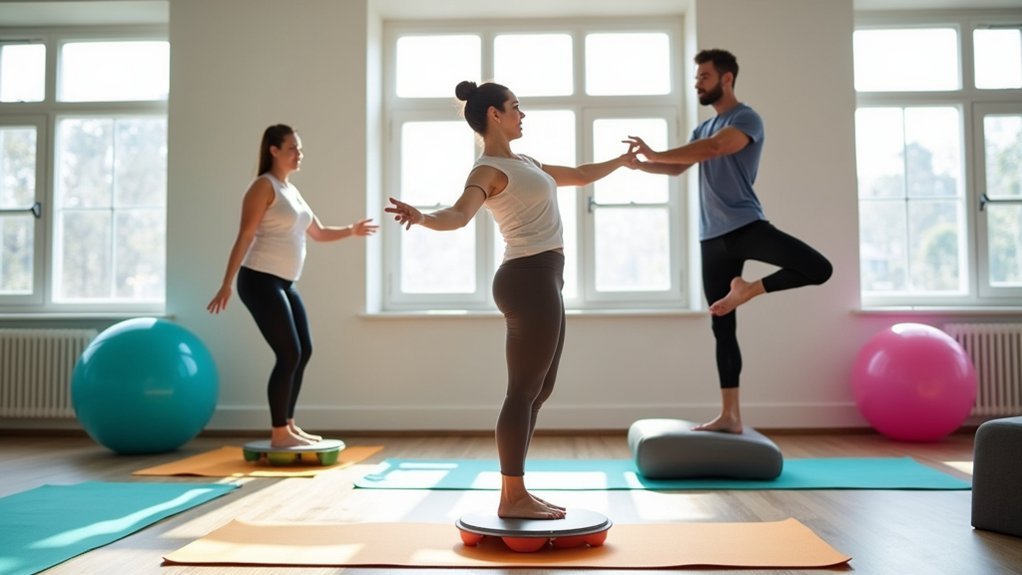


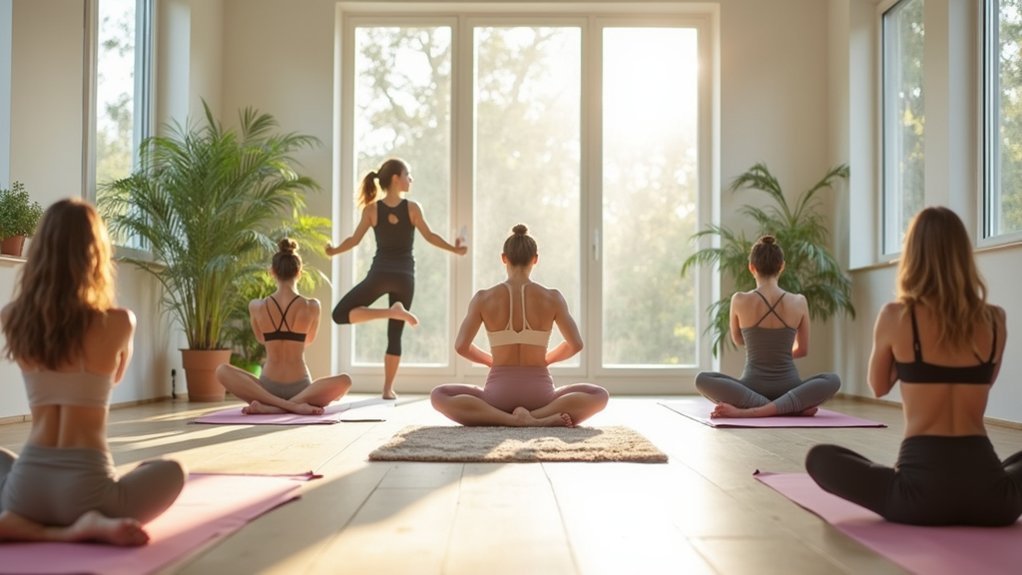
Leave a Reply